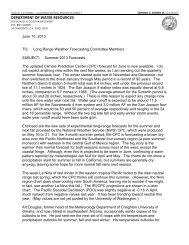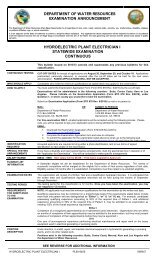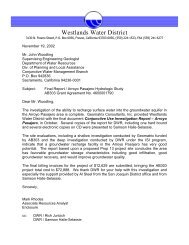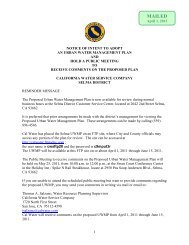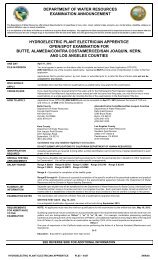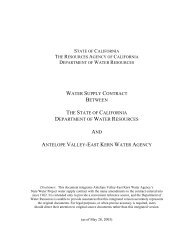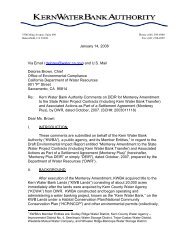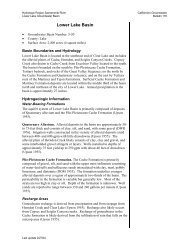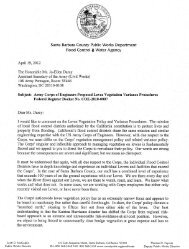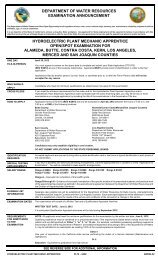Bulletin 1.pdf - California Department of Water Resources - State of ...
Bulletin 1.pdf - California Department of Water Resources - State of ...
Bulletin 1.pdf - California Department of Water Resources - State of ...
You also want an ePaper? Increase the reach of your titles
YUMPU automatically turns print PDFs into web optimized ePapers that Google loves.
WATER RESOURCES OF CALIFORNIA 497<br />
RUNOFF<br />
Estimated mean seasonal natural run<strong>of</strong>f <strong>of</strong> the Lahontan Area for<br />
the 53-year period from 1894-95 to 1946-47 is 3,177,000 acre-feet, or 4.5<br />
percent <strong>of</strong> total surface run<strong>of</strong>f <strong>of</strong> the <strong>State</strong>. Minimum seasonal run<strong>of</strong>f<br />
amounting to 930,000 acre-feet occurred in 1923-24, and the maximum,<br />
totalling 7,070,000 acre-feet, in 1906-07. <strong>Water</strong> supply during each year<br />
<strong>of</strong> the 10-year period from 1923-24 to 1932-33, except 1926-27, was less<br />
than the 53-year seasonal mean, and the average was only 63 percent <strong>of</strong><br />
this long-time mean.<br />
Snow falls on large portions <strong>of</strong> the tributary drainage <strong>of</strong> the Lahontan<br />
Area. Consequently, a substantial portion <strong>of</strong> seasonal run<strong>of</strong>f is delayed<br />
until late spring and early summer. For Truckee River, a typical<br />
Lahontan Area stream that flows from the Sierra Nevada, snow melt<br />
contributes 95 percent <strong>of</strong> seasonal run<strong>of</strong>f. Minimum run<strong>of</strong>f in the Area<br />
occurs from August to October, inclusive. On Truckee River run<strong>of</strong>f<br />
during these months is only 4.9 percent <strong>of</strong> the seasonal total.<br />
Stream gaging stations in the Lahontan Area, are listed in Table 71<br />
together with the average, maximum and minimum seasonal run<strong>of</strong>f for<br />
stations with more than 10 years <strong>of</strong> record. Longest available records <strong>of</strong><br />
stream flow are for Truckee River at or near the state line, and for Owens<br />
River near Round Valley. The record for the 'rruckee has been maintained<br />
since September, 1899, and that for Owens River since August,<br />
1903, except from October, 1923, to March, 1927. Records for these two<br />
stations are no longer published by the Geological Survey, but may be<br />
secured from the Federal Court <strong>Water</strong>master for Truckee River and<br />
from the <strong>Department</strong> <strong>of</strong> <strong>Water</strong> and Power <strong>of</strong> the City <strong>of</strong> Los Angeles<br />
for Owens River.<br />
Estimated mean seasonal natural run<strong>of</strong>f <strong>of</strong> the 53 years from 1894-95<br />
to 1946-47, shown in Table 72, has been prepared i:r{ the same manner<br />
as corresponding tables in preceding chapters. For stations with partial<br />
records, mean seasonal run<strong>of</strong>f shown is the mean <strong>of</strong> estimated natural<br />
flow for each season <strong>of</strong> the 53-year period. At locations where records are<br />
not available, only directly derived long-time mean estimates are given.<br />
Estimates <strong>of</strong> seasonal natural run<strong>of</strong>f <strong>of</strong> main stream and tributary<br />
basins having records, presented in Table 73, were made in accordance<br />
with principles outlined in Chapter III. Estimates <strong>of</strong> run<strong>of</strong>f from drainage<br />
basins where records were not available were made by comparison<br />
with run<strong>of</strong>f from other basins. In deriving the 53-year seasonal mean for<br />
unmeasured streams discharging into lakes in the northern portion <strong>of</strong><br />
the Area, inflow to a lake, computed from records <strong>of</strong> lake levels, was taken<br />
to be run<strong>of</strong>f <strong>of</strong> the stream during the period <strong>of</strong> record. A relationship<br />
was then established with an adjacent stream, and the missing record<br />
was estimated by the third method <strong>of</strong> restoring missing records described<br />
in Chapter III.<br />
Estimates <strong>of</strong> mean seasonal run<strong>of</strong>f for streams or basins for which<br />
no records <strong>of</strong> any type existed were made by comparison with run<strong>of</strong>f <strong>of</strong><br />
adjacent areas, on the basis <strong>of</strong> geographical, geological and meteorological<br />
conditions. The portion <strong>of</strong> mean seasonal run<strong>of</strong>f that was estimated for<br />
the Lahontan Area approximates 1,183,000 acre-feet, the remaining<br />
1,994,000 acre-feet being based on records.<br />
An unusual feature <strong>of</strong> the natural flow estimate for Truckee River,<br />
in Table 73, is the occurrence in several years <strong>of</strong> negative values in esti-



